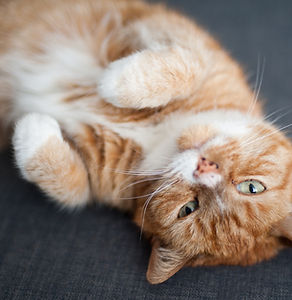
What You Need to Know When Your Cat is Undergoing Anesthesia
As a responsible pet owner, ensuring the health and safety of your feline companion is always a priority. One aspect of veterinary care that may cause concern for many cat owners is anesthesia. Whether your cat is undergoing a routine procedure, such as a spay or neuter, or a more complex surgery, anesthesia is often necessary to ensure your cat remains pain-free and still during the procedure. Here at Las Vegas Cat Hospital, we understand that this can be a scary time for owners and we believe that understanding the process, potential risks, and how to prepare can help ease your mind and ensure your cat’s safety throughout the procedure.
1. Why Is Anesthesia Necessary for Cats?
Anesthesia is a medically induced state in which your cat is made unconscious and pain-free for a procedure. This allows our veterinarians to perform the necessary tasks, whether they are diagnostic (like X-rays) or surgical, without causing distress or harm to your pet. In some cases, anesthesia is also used to sedate cats for medical treatments that require them to remain still or relaxed.
There are two main types of anesthesia used in veterinary care:
-
General Anesthesia: This is the most common type, and it involves a combination of injectable drugs and gas anesthetics that induce a deep sleep-like state. The cat is fully unconscious and unaware of the procedure.
-
Injectable Sedation: This is used for shorter procedures with minimal pain involved such as an abdominal ultrasound. Often, this type of anesthesia is reversed prior to your cat being discharged.
2 . Preparing Your Cat For Anesthesia
Proper preparation is crucial for the safety and success of the procedure. Here's what you need to do before your cat undergoes anesthesia:
-
Fasting: Our veterinarians recommend that your cat fast for 12 hours before undergoing any type of sedation or anesthesia. This is to reduce the risk of vomiting or aspiration (inhalation of food or liquid into the lungs) while under anesthesia. Ensure that you follow the vet's instructions regarding food and water restrictions.
-
Health Assessment: We will always perform a physical examination to assess your cat’s overall health and determine the level of anesthetic risk for your cat. In most cases, we recommend blood work is performed prior to anesthesia to assess your cat’s organ function and suitability for anesthesia. In older pets we also recommend chest x-rays to assess their heart and lungs to further determine high risk patients.
-
Medication Review: If your cat is on any medications (such as heart or pain medications), it is very important to inform us, especially at check in the morning of the anesthetic procedure. Some medications may need to be temporarily stopped prior to the procedure to reduce risks associated with anesthesia.
3. The anesthesia Process
Once your cat is at the veterinary clinic, here's an overview of what will happen:
● Pre-Anesthesia Sedation: In most cases, your cat will receive a mild sedative or tranquilizer to help them relax before the anesthetic drugs are administered. This helps reduce anxiety, allow placement of an IV catheter and makes the induction of anesthesia smoother.
● Induction: Once sedated, the veterinarian will administer the anesthetic drugs either intravenously (through an IV catheter) or by inhalation. Intravenous drugs quickly induce unconsciousness, while gas anesthesia may take a few moments to take effect.
● Monitoring: Throughout the procedure, your cat will be closely monitored by our veterinary staff. We closely monitor vital signs, including heart rate, blood pressure, temperature, oxygen levels, CO2 levels, respiratory rate, capillary refill time, and heart rhythm to ensure the anesthesia is not affecting your cat’s health adversely.
○ Monitoring Equipment: At Las Vegas Cat Hospital, we have extensive monitoring protocols and specialized equipment, such as ECGs (electrocardiograms), oscillometric blood pressure monitors and capnographs, to monitor your cat’s heart rhythm, blood pressure, and carbon dioxide output. These are parameters that are not legally required but are important in delivering the best care possible to your feline loved one.
4. Risk of Anesthesia
Although anesthesia is generally safe for cats, there are risks involved, as with any medical procedure. These risks can be minimized through proper preparation, monitoring, and skilled veterinary care.
● Reaction to Anesthetic Drugs: Cats can sometimes have allergic or idiosyncratic reactions to anesthetic agents, though this is rare. As Las Vegas Cat Hospital, we use an individual tailored approach to anesthesia, carefully choosing the most appropriate anesthetic drugs based on your particular cat's health history.
● Respiratory or Cardiovascular Issues: Some cats may experience respiratory or heart-related issues under or after anesthesia, particularly if they have pre-existing conditions like heart disease or respiratory problems. Pre-operative diagnostics and close monitoring helps detect these issues early.
● Hypothermia: In all species, anesthesia can cause a drop in body temperature, but this is even more important in cats given their small body size. We will always use warming devices to help keep your cat’s body temperature stable throughout the procedure and in the recovery period.
● Nausea with anesthesia: Many cats experience side effects such as nausea, vomiting, or disorientation as they wake from anesthesia. To prevent this and the complication of
aspiration pneumonia, every patient undergoing sedation or anesthesia at Las Vegas Cat Hospital will receive an anti-emetic medication as part of their anesthesia protocol to ease their discomfort in recovery.
5. Post-Anesthesia Recovery
Once the procedure is complete, your cat will be moved to a recovery area where they will gradually wake up from anesthesia. The recovery process varies, depending on the procedure and the cat's health status. Here's what you can expect:
● Waking Up: It may take anywhere from a few minutes to several hours for your cat to fully wake up. Cats often appear groggy, confused, or disoriented after anesthesia. This is completely normal and typically resolves within a few hours.
● Monitoring: The Las Vegas Cat Hospital team will continue to monitor your cat’s vital signs during the recovery phase to ensure they are stable and comfortable. Some cats may need additional support, such as oxygen therapy or additional pain management.
● Eating and Drinking: After anesthesia, your cat may not feel like eating or drinking immediately. They should be kept in a quiet, calm environment until they are fully alert. We will always provide care instructions on when to offer food or water as part of your cat's discharge paperwork.
● Pain Management: Cats are very good at hiding their discomfort. If your cat underwent surgery or a procedure that could cause discomfort, we will prescribe pain medication. Follow the prescribed instructions carefully, as pain management is a crucial part of the recovery process.
6. Signs of Complications After Anesthesia
While most cats recover without issue, it’s essential to keep an eye on your cat during the first 24-48 hours after anesthesia.
Contact us immediately if you notice any of the following signs:
● Vomiting or diarrhea
● Trouble breathing or coughing
● Loss of appetite or refusal to drink
● Swelling or redness at the injection site (if an IV catheter was used)
● Unusual behavior (aggression, confusion, or excessive vocalization)
● Excessive lethargy or inability to stand or walk
Conclusion
Anesthesia is a crucial part of many veterinary procedures, allowing your cat to undergo necessary medical treatment while remaining pain-free and still. By understanding the process, risks, and recovery steps, you can be more confident in the safety of your cat during the procedure. Open communication with Dr. Love and our team, proper preparation, and post-anesthesia care will ensure the best possible outcome for your feline companion.
If you have concerns about anesthesia or your cat's specific health conditions, don't hesitate to ask us for more detailed information or clarification. We understand this can be a nerve-wracking time and we are happy to address any questions you may have and help guide you through the process.



